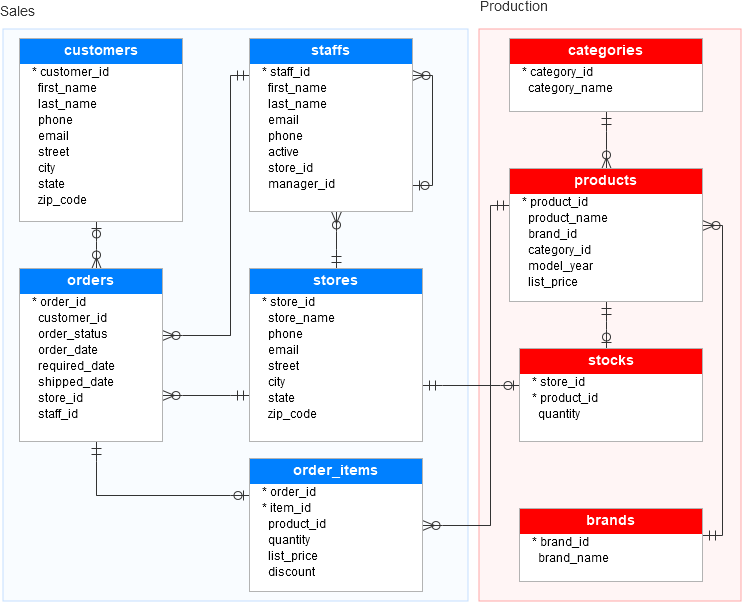Summary: in this tutorial, you’ll learn about the SQL Server sample database called BikeStores.
The following illustrates the BikeStores database diagram:

As you can see from the diagram, the BikeStores sample database has two schemas sales and production, and these schemas have nine tables.
Database Tables
Table sales.stores
The sales.stores table includes the store’s information. Each store has a store name, contact information such as phone and email, and an address including street, city, state, and zip code.
CREATE TABLE sales.stores (
store_id INT IDENTITY (1, 1) PRIMARY KEY,
store_name VARCHAR (255) NOT NULL,
phone VARCHAR (25),
email VARCHAR (255),
street VARCHAR (255),
city VARCHAR (255),
state VARCHAR (10),
zip_code VARCHAR (5)
);Code language: SQL (Structured Query Language) (sql)Table sales.staffs
The sales.staffs table stores the essential information of staffs including first name, last name. It also contains the communication information such as email and phone.
A staff works at a store specified by the value in the store_id column. A store can have one or more staffs.
A staff reports to a store manager specified by the value in the manager_id column. If the value in the manager_id is null, then the staff is the top manager.
If a staff no longer works for any stores, the value in the active column is set to zero.
CREATE TABLE sales.staffs (
staff_id INT IDENTITY (1, 1) PRIMARY KEY,
first_name VARCHAR (50) NOT NULL,
last_name VARCHAR (50) NOT NULL,
email VARCHAR (255) NOT NULL UNIQUE,
phone VARCHAR (25),
active tinyint NOT NULL,
store_id INT NOT NULL,
manager_id INT,
FOREIGN KEY (store_id)
REFERENCES sales.stores (store_id)
ON DELETE CASCADE ON UPDATE CASCADE,
FOREIGN KEY (manager_id)
REFERENCES sales.staffs (staff_id)
ON DELETE NO ACTION ON UPDATE NO ACTION
);Code language: SQL (Structured Query Language) (sql)Table production.categories
The production.categories table stores the bike’s categories such as children bicycles, comfort bicycles, and electric bikes.
CREATE TABLE production.categories (
category_id INT IDENTITY (1, 1) PRIMARY KEY,
category_name VARCHAR (255) NOT NULL
);Code language: SQL (Structured Query Language) (sql)Table production.brands
The production.brands table stores the brand’s information of bikes, for example, Electra, Haro, and Heller.
CREATE TABLE production.brands (
brand_id INT IDENTITY (1, 1) PRIMARY KEY,
brand_name VARCHAR (255) NOT NULL
);Code language: SQL (Structured Query Language) (sql)Table production.products
The production.products table stores the product’s information such as name, brand, category, model year, and list price.
Each product belongs to a brand specified by the brand_id column. Hence, a brand may have zero or many products.
Each product also belongs a category specified by the category_id column. Also, each category may have zero or many products.
CREATE TABLE production.products (
product_id INT IDENTITY (1, 1) PRIMARY KEY,
product_name VARCHAR (255) NOT NULL,
brand_id INT NOT NULL,
category_id INT NOT NULL,
model_year SMALLINT NOT NULL,
list_price DECIMAL (10, 2) NOT NULL,
FOREIGN KEY (category_id)
REFERENCES production.categories (category_id)
ON DELETE CASCADE ON UPDATE CASCADE,
FOREIGN KEY (brand_id)
REFERENCES production.brands (brand_id)
ON DELETE CASCADE ON UPDATE CASCADE
);Code language: SQL (Structured Query Language) (sql)Table sales.customers
The sales.customers table stores customer’s information including first name, last name, phone, email, street, city, state and zip code.
CREATE TABLE sales.customers (
customer_id INT IDENTITY (1, 1) PRIMARY KEY,
first_name VARCHAR (255) NOT NULL,
last_name VARCHAR (255) NOT NULL,
phone VARCHAR (25),
email VARCHAR (255) NOT NULL,
street VARCHAR (255),
city VARCHAR (50),
state VARCHAR (25),
zip_code VARCHAR (5)
);Code language: SQL (Structured Query Language) (sql)Table sales.orders
The sales.orders table stores the sales order’s header information including customer, order status, order date, required date, shipped date.
It also stores the information on where the sales transaction was created (store) and who created it (staff).
Each sales order has a row in the sales_orders table. A sales order has one or many line items stored in the sales.order_items table.
CREATE TABLE sales.orders (
order_id INT IDENTITY (1, 1) PRIMARY KEY,
customer_id INT,
order_status tinyint NOT NULL,
-- Order status: 1 = Pending; 2 = Processing; 3 = Rejected; 4 = Completed
order_date DATE NOT NULL,
required_date DATE NOT NULL,
shipped_date DATE,
store_id INT NOT NULL,
staff_id INT NOT NULL,
FOREIGN KEY (customer_id)
REFERENCES sales.customers (customer_id)
ON DELETE CASCADE ON UPDATE CASCADE,
FOREIGN KEY (store_id)
REFERENCES sales.stores (store_id)
ON DELETE CASCADE ON UPDATE CASCADE,
FOREIGN KEY (staff_id)
REFERENCES sales.staffs (staff_id)
ON DELETE NO ACTION ON UPDATE NO ACTION
);Code language: SQL (Structured Query Language) (sql)Table sales.order_items
The sales.order_items table stores the line items of a sales order. Each line item belongs to a sales order specified by the order_id column.
A sales order line item includes product, order quantity, list price, and discount.
CREATE TABLE sales.order_items(
order_id INT,
item_id INT,
product_id INT NOT NULL,
quantity INT NOT NULL,
list_price DECIMAL (10, 2) NOT NULL,
discount DECIMAL (4, 2) NOT NULL DEFAULT 0,
PRIMARY KEY (order_id, item_id),
FOREIGN KEY (order_id)
REFERENCES sales.orders (order_id)
ON DELETE CASCADE ON UPDATE CASCADE,
FOREIGN KEY (product_id)
REFERENCES production.products (product_id)
ON DELETE CASCADE ON UPDATE CASCADE
);Code language: SQL (Structured Query Language) (sql)Table production.stocks
The production.stocks table stores the inventory information i.e. the quantity of a particular product in a specific store.
CREATE TABLE production.stocks (
store_id INT,
product_id INT,
quantity INT,
PRIMARY KEY (store_id, product_id),
FOREIGN KEY (store_id)
REFERENCES sales.stores (store_id)
ON DELETE CASCADE ON UPDATE CASCADE,
FOREIGN KEY (product_id)
REFERENCES production.products (product_id)
ON DELETE CASCADE ON UPDATE CASCADE
);Code language: SQL (Structured Query Language) (sql)Click the following link to download the sample database script:
Download SQL Server Sample Database
Now, you should be familiar with the BikeStores sample database and ready to load it into the SQL Server.